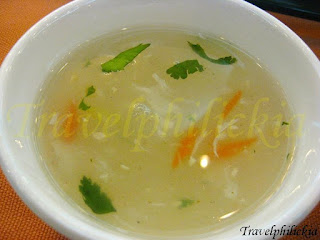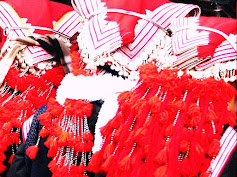Didn't take breakfast at the hotel as its selection was not satisfactory, therefore I decided to have instant noodles back in the hotel room.
Snow-capped Mountains
Weather dropped to freezing temperature overnight in Tibet, thus snow was formed and covered the mountain tops. With the sun shining bright in the morning, we saw the majestic scene of snow covering the mountain tops (photos below) from our hotel room.

 Located on the third floor, our hotel room had an almost parallel view of the Potala Palace (photo below). The palace stands 300-meters above the valley floor on the Red Hill.
Located on the third floor, our hotel room had an almost parallel view of the Potala Palace (photo below). The palace stands 300-meters above the valley floor on the Red Hill.
Situated in the centre of Lhasa Valley, the surrounding snow-capped mountains could also be clearly seen (photo below).
 We then decided to walk out of the hotel to have a better view of the stunning scene (photos below). Even with the strong sunshine, the temperature was lower compared to its previous days. After taking a few photo shots, we then hurried back to the hotel.
We then decided to walk out of the hotel to have a better view of the stunning scene (photos below). Even with the strong sunshine, the temperature was lower compared to its previous days. After taking a few photo shots, we then hurried back to the hotel.




After checked out from the Jiangsu Shengtaiyuan Hotel at about 11.30 am, we then proceeded for our lunch. While on our way to the restaurant, we saw similar stunning scene of snow-capped mountains (photos below).

 Lunch
LunchBack to the usual Xingdada Cellar (兴达大酒庄) Restaurant (left photo below). A total of six dishes including a soup were served (right photo below).

 After lunch we then proceeded to the Gonggar Airport. Perhaps it was the last part of the journey in Tibet, I then took the final pictures of the snow-covered mountains in Tibet (photos below).
After lunch we then proceeded to the Gonggar Airport. Perhaps it was the last part of the journey in Tibet, I then took the final pictures of the snow-covered mountains in Tibet (photos below).

 Lhasa Airport Expressway
Lhasa Airport ExpresswayOfficially known as "Lhasa to Gonggar Airport Expressway" (拉萨至贡嘎机场高速公路), it is an expressway that links Lhasa Gonggar Airport to the city centre of Lhasa. The expressway is 37.8-km long with bridges and tunnels. Culvert, structure that channels waterway, was built under the expressway to allow streams from Lhasa River to pass through (photos below).

 Completed in July 2011, the expressway has four lanes (photos below) and allowed travellers to shorten half the time to about 30-minutes compared to the previous route.
Completed in July 2011, the expressway has four lanes (photos below) and allowed travellers to shorten half the time to about 30-minutes compared to the previous route.

 Flight to Xi'an
Flight to Xi'anAfter about an hour's drive, we reached Lhasa Gonggar Airport at about 13.10 pm. Really impressed by the majestic scenery of continuous mountains surrounding the airport. We then boarded domestic flight MU 2336 at 1530 hours (left photo below). Simple snacks were served during this short flight of 2 hours and 40 minutes (right photo below).

 Reached Xi'an Xiangyang International Airport at 1810 hours. We were greeted by the same Xi'an tour guide at the airport and then transferred back to Orient Hotel Xi'an.
Reached Xi'an Xiangyang International Airport at 1810 hours. We were greeted by the same Xi'an tour guide at the airport and then transferred back to Orient Hotel Xi'an.Dinner
Had late dinner at the second floor of the hotel at about 8.20 pm (left photo below). After some waiting, fried rice was first served as staple food (right photo below).

 This was followed by 8 dishes, including noodles and snacks, in this sumptuous dinner (photos below).
This was followed by 8 dishes, including noodles and snacks, in this sumptuous dinner (photos below).








After a heavy dinner, we were back to our hotel room for rest.
Day Ten
Had a good breakfast at the hotel.
After checked out from the Orient Hotel Xi'an, we then started our exploration in the ancient city of Xi'an.
Giant Wild Goose Pagoda (大雁塔)
Giant Wild Goose Pagoda is a monumental Buddhist pagoda standing in the Daci'en temple complex (photos below).
Originally built with only five stories in around year 648 during reign of Emperor Gaozong of Tang dynasty. It was then added another five stories by the Lady Emperor Wu Zetian by year 704. A massive earthquake in 1556 damaged the pagoda and reduced it to current seven stories. It was said that after that addition came the saying-'Saving a life exceeds building a seven-storey pagoda'. The pagoda was extensively repaired during the Ming dynasty and most recently in year 1964.
We didn't enter the pagoda due to the limited time. Instead took some close-up shots of the pagoda. Realized that the structure is rather large compared to the visitor and workers (photos below). Really worried for the stuff who was doing a dangerous job.

 Giant Wild Goose Pagoda Scenic Area
Giant Wild Goose Pagoda Scenic AreaThere are many featured squares and gardens around the Giant Wild Goose Pagoda and Daci'en temple complex, which provides the locals and tourists with wonderful places to explore.
North Square
- The most remarkable one should be the North Square boasting the largest musical fountain in Asia (photos below). Best time to visit this place is in the evening as the whole place will be lighted up.

 On both sides of the rectangular fountain stands the shops and ticket offices in the style of traditional element (photos below).
On both sides of the rectangular fountain stands the shops and ticket offices in the style of traditional element (photos below).


- Located at the east of the pagoda is the Shaanxi Opera Garden (photos below).

 There are colored painting statues, local opera copper relief, statuaries of famous Shaanxi opera writers and vivid scene of some classical Shaanxi opera plays (photos below). These present the unique charm of the Shaanxi Opera: Qinqiang (秦腔).
There are colored painting statues, local opera copper relief, statuaries of famous Shaanxi opera writers and vivid scene of some classical Shaanxi opera plays (photos below). These present the unique charm of the Shaanxi Opera: Qinqiang (秦腔).


After the walking tour, we went to the Chinese restaurant "汉唐天下 ▪ 私房菜" for lunch (left photo below). This was the same restaurant where we had lunch on our first day. Similar to the Orient hotel Xi'an, fried rice was also served as staple food (right photo below).

 This was followed by 6 dishes in this delicious meal (photos below).
This was followed by 6 dishes in this delicious meal (photos below).





 Xi'an Muslim Quarter
Xi'an Muslim QuarterAfter lunch, we were brought to Xi'an Muslim Quarter. Also known as Huimin Street (回民街), this main food street area consists of several intersecting roads, including Beiyuanmen Street, North Guangji Street, Xiyangshi Street (left photo below), Dapiyuan Steet and Huajue Xiang (right photo below).

 The history of the Xi'an Muslim Quarter can be traced back to the Tang Dynasty, when Muslim merchants came to and aggregated in Chang'an, today's Xi'an, via the Silk Road.
The history of the Xi'an Muslim Quarter can be traced back to the Tang Dynasty, when Muslim merchants came to and aggregated in Chang'an, today's Xi'an, via the Silk Road. This bustling area offers an abundance of Muslim Street food stalls, restaurants, tea houses and different souvenirs shops (photos below).




One of the most famous dishes of Xi'an is the Roujiamo (肉夹馍) which is marinated beef or lamb stuffed inside a freshly baked bun (photos below).


Another traditional Uygur dish found here is the Yangrou Paomo (羊肉泡馍) which is pita bread soaked in lamb soup (left photo below). Xi'an is also known for its cold noodles which can be made from rice or from flour (right photo below).


There are also lamb trotters (羊蹄) available (left photo below) and Mung Bean Cake (绿豆糕) on sale (right photo below).


Bell Tower and Drum Tower
Located near to the Muslim Quarter, the Bell and Drum Towers are located in the heart of the Xi'an city.
Bell Tower
- Built in 1384 during the Ming dynasty, the Bell Tower has a square base, and covers an area of 1,377 meters square and close to height of 40-meters (left photo below). The tower contains several large bronze-cast bells made from Tang dynasty.
- Erected in 1380 during the early Ming dynasty, the Drum Tower got its name from the huge drum located within the building (right photo below). In contrast to the Bell Tower where the bell was stricken at dawn, the drum was beaten at sunset to indicate the end of the day.


The fortifications of Xi'an represent one of the oldest, largest and best-preserved Chinese city walls (left photo below). Built during the early Ming dynasty, the rectangular wall encloses an area of about 14 square kilometres. New gates were constructed during the Republican rule to allow traffic through its wall (right photo below). The top of the wall is a walkway which would typically take four hours to cover.

 Currently the Xi'an City Wall is on the tentative list of UNESCO's world Heritage Site under the list for "City Walls of the Ming and Qing Dynasties".
Currently the Xi'an City Wall is on the tentative list of UNESCO's world Heritage Site under the list for "City Walls of the Ming and Qing Dynasties".Flight to Singapore
After exploring the ancient Xi'an by foot, we were then transferred to Xi'an Xianyang International Airport.
Took flight MU 5093 which departed at 1850 hours on time (photo below).
Dinner of noodles was served (left photo below) in the section from Xi'an to Kunming, while light snacks were served (right photo below) in the section from Kunming to Singapore.

 We reached Singapore at about 2 am in the morning.
We reached Singapore at about 2 am in the morning.With this, it ended our 10-days trip to Xi'an, Qinghai and Tibet.
 Posts RSS
Posts RSS








